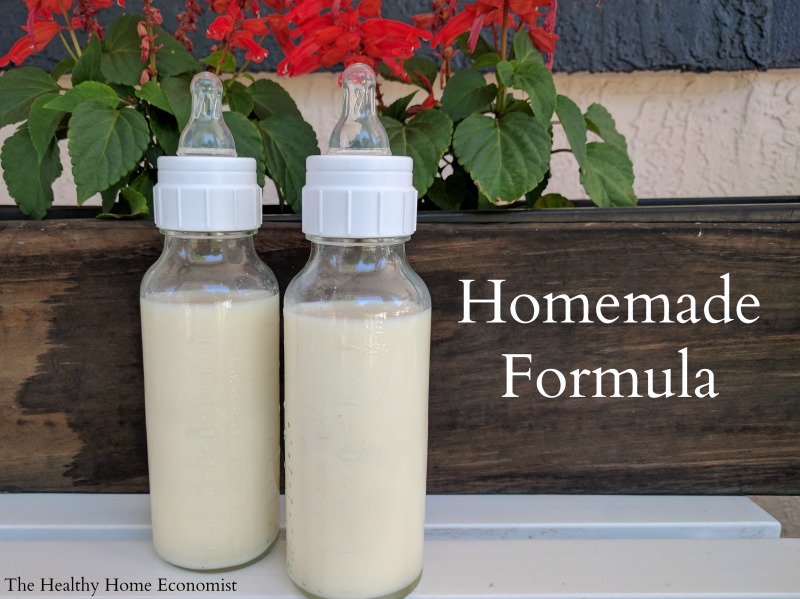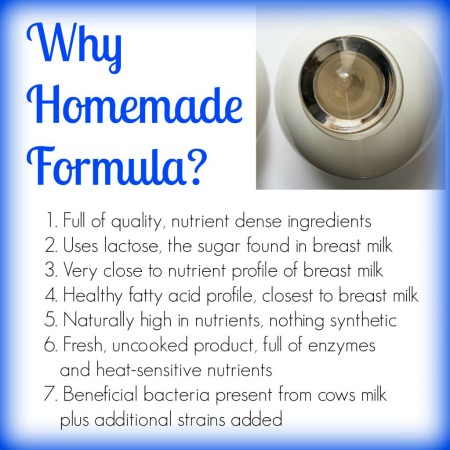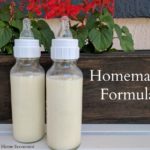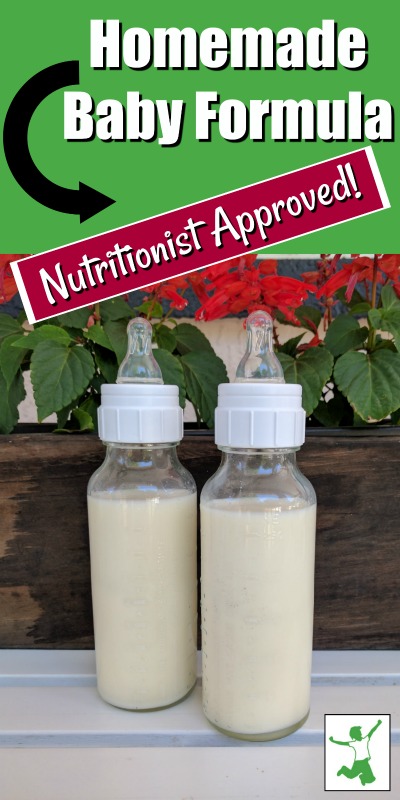Table of Contents[Hide][Show]
A nourishing homemade baby formula using safe, whole ingredients. This recipe was developed and tested by Dr. Mary Enig, a PhD Nutritionist and originally published in Nourishing Traditions cookbook in 1996. It was formulated to match breastmilk as closely as possible and is also suitable for infants. Source: Weston A. Price Foundation

There is no doubt that breastfeeding your baby is the best option for the child’s long-term health and development. Human breastmilk from a well-nourished mother is the perfect food for baby. However, in circumstances where the child is adopted or the Mother finds herself unable to breastfeed, formula feeding becomes necessary. In those cases, homemade baby formula is best.
Using a baby formula recipe that closely matches the nutritional profile of breastmilk is a far better choice than even organic baby formula from the health food store. More on this below.
Note: Donor programs are widely available for human breastmilk. But, the diets of the donor mothers are unknown and most likely nutritionally insufficient. In addition, breastmilk banks pasteurize the donated breastmilk which destroys much of the nutritional benefit. Unless you are fortunate to have a trusted and direct donor milk source in your community, avoid this option!
Dangers of Commercial Formula
Commercial formulas are always a poor choice for a number of reasons. First of all, formula manufacturers line the cans with the chemical BPA. This substance disrupts hormone development and is a probable contributor to early puberty in girls, and ADHD, urogenital abnormalities, and other ills in boys.
The European Food Safety Authority found that canned commercial formula is a significant source of BPA for infants, exposing the child to 13mcg of BPA per kg of body weight per day! BPA-free formula cans are no better. The chemical BPS is typically used instead which is just as dangerous.
Beware that manufacturers pack even organic commercial formula like Earth’s Best in BPA cans. Worse, they use organic brown rice syrup as the primary sweetener which is known to be frequently contaminated with arsenic.
In addition, all commercial milk formulas are processed at extremely high temperatures which violently denature the fragile milk proteins, render them allergenic, and add carcinogens to the final product. Soy infant formula is the worst. Obscenely high processing temperatures not only denature the proteins but large levels of phytic acid in soy block mineral absorption by the infant. Moreover, soy-based plant estrogens disrupt the hormonal development of the baby!
It seems that for the concerned Mother who is unable to breastfeed, learning how to make baby formula at home with safe, pure ingredients is the most prudent way to go!
Why Make Homemade Formula Even if You Are Breastfeeding
In the video below, I show you how to make your own safe, healthy raw milk homemade formula for your baby.
The recipe I follow was originally published in the cookbook Nourishing Traditions in 1996 and developed by Dr. Mary Enig.
Even though I breastfed each of my children for at least 2 years, I made this exact formula for my own children when I was away for the day or the evening as pumping was not an option that worked well for me.
I even used this homemade formula for an entire day once when I had some dental work done and was advised to pump and discard for 24 hours.
As a result, even successfully breastfeeding Moms can use this wonderful homemade formula as a supplement when necessary to their own nutrient-dense breastmilk!
It is advised that even breastfeeding Mothers have the ingredients for this formula on hand for an emergency. If Mom is sick or otherwise unable to nurse, Dad can step in and make this safe alternative until Mom is back on her feet. It takes a few days to a week to gather all the ingredients together to make this formula, which is why I advise having them on hand at all times.
Homemade Most Nutritious
The image below lists the reasons why it is worth it nutritionally to make formula yourself for your precious baby!
You can order all of the required ingredients for the homemade baby formula in one package from this reputable, vetted source.
Moms who have successfully used this formula feeding your children, please post about your experience in the comments section to encourage those who are considering it and need some Mom to Mom encouragement!

Where to Source Quality Milk
The most widely available grass-fed milk around the world is from cows. This is usually the most budget-friendly and easily sourced milk for this recipe for homemade formula.
If only goat milk is available in your area, this recipe for goat milk baby formula can be used instead. When using milk from ewes, please refer to the linked article for an adjusted recipe; one of the benefits of sheep milk is that it is higher in healthy fats than either goat or cow milk.
Camel milk formula is another option that is a particularly digestible form of dairy and growing in popularity around the world.
Alternatively, you can use low temp (vat) pasteurized, non-homogenized whole milk cultured with a piima or kefir starter. Then substitute the piima milk or kefir for the raw milk portion of the formula recipe. Cold-pressed raw milk also must be cultured before using it as it contains no probiotics.
Do NOT use ultrapasteurized (UHT) milk even if organic as it is too highly processed and extremely allergenic!
It is also best to avoid all types of powdered milk for this recipe. The factory process of making milk powder reduces nutrition considerably and denatures it, which makes it more likely baby will have an allergic reaction.
Dairy Allergy Option
If all types of dairy prove unsuitable for your baby, make this nondairy baby formula recipe instead. It uses a base of homemade bone broth as a substitute for milk. It is important not to utilize a plant-based or otherwise vegan baby formula recipe.
Avoid buying bone broth to make the dairy-free formula. Make it yourself! Manufacturers of commercial bone broth, even if authentic, may water down the end product. This is apparent if it does not gel when chilled in the refrigerator.
Many brands have toxic packaging issues as well. If you must buy it in a pinch, see my shopping guide page for vetted brands that are safe.

Homemade Baby Formula Recipe (for infants too)
A nourishing baby formula recipe you can make at home with safe, whole ingredients developed and tested by a PhD nutritionist to match breastmilk as closely as possible. Also suitable for infants.
Ingredients
- 2 cups raw cow milk OR organic whole milk yogurt
- 1 7/8 cups filtered water
- 1/4 cup liquid whey
- 4 Tbl lactose
- 1/4 tsp Bifidobacterium infantis powder
- 2-4 Tbl raw or pasteurized cream
- 1/2 tsp cod liver oil unflavored
- 1/4 tsp butter oil unflavored
- 1 tsp sunflower oil preferably organic
- 1 tsp extra virgin olive oil preferably organic
- 2 tsp virgin coconut oil preferably organic
- 2 tsp nutritional yeast
- 2 tsp gelatin
- 1/4 tsp acerola powder
Instructions
-
Fill a 2 cup Pyrex measuring cup with filtered water and remove 2 TBL (this will give you 1 7/8 cup water).
-
Pour about half the water into a pan and turn burner on medium.
-
Add the gelatin and lactose and let dissolve, stirring occasionally.
-
When gelatin and lactose are dissolved, remove pan from heat and add the rest of the water to cool.
-
Stir in the coconut oil and butter oil until melted.
-
Put remaining ingredients in a glass blender.
-
Add the water mixture and blend for about 3 seconds.
-
Place formula in glass baby bottles or a glass jar and refrigerate.
-
Before giving to baby, warm glass bottle in a pan of hot water or a bottle warmer. NEVER microwave baby bottles!
Recipe Video
Recipe Notes
If using raw cow milk from holstein cows, use 4 Tbl of extra cream (otherwise use 2 Tbl extra cream).
If choosing to make this homemade formula with camel milk, be sure to include 4 Tbl extra cream as camel milk is lower in cream than cow milk.
Do not use high oleic sunflower oil. Use only the brand recommended in the ingredients list which is cold pressed, organic, unrefined, and low oleic.
*Do NOT use powdered whey from the store as it is denatured. Avoid whey from making cheese as it will curdle the formula.
*Do not substitute pasteurized or powdered milk as these are heavily processed, denatured and allergenic foods.
*Do NOT use ultrapasteurized (UHT) cream. It is highly allergenic. Raw or pasteurized cream is acceptable.
*Do NOT use fish oil or krill oil instead of high vitamin cod liver oil as they do not contain any Vitamin D and very little to no Vitamin A.
Collagen powder may be substituted for the gelatin in a pinch (more on peptides in baby formula in this article).
If you are wondering where is the iron in homemade baby formula, this article provides an explanation.
If baby experiences constipation using this formula, try adding 1 tsp of molasses to each batch. This should help move things along.
How to Transition to DIY Formula
Once you’ve viewed the video, gathered the ingredients, and made your first batch, how do you feed it to your baby for the first time?
It is important not to switch all at once as this can cause gas, excessive spit-up, or an uncomfortable change in diaper habits such as constipation or overly loose stools.
Start by giving your baby three-quarters of the old formula blended with one-quarter of the homemade. Try this ratio for a day or two and see how your infant responds.
If no digestive upset or major change in diaper habits occurs, increase the amount to a 50-50 blend of old formula to homemade. Observe for another day or two as before.
If no major issues, increase once again to three-quarters homemade formula to one-quarter old formula. If baby does well on this blend for a third time, you are ready to fully transition to the homemade formula.
At any time during the transition, symptoms of intolerance emerge, back up to the previous successful blend ratio and stay there for a day or two before attempting to increase once again.
Homemade Formula FAQ
Weston Price Foundation
Feeding an Adopted Baby
Traveling Tips with Baby Formula Made at Home
Iron in Baby Formula
Collagen Peptides instead of Gelatin for Homemade Formula?










Hi Sarah,
I have a question about the Acerola powder. I was a little disappointed when I noticed that the kit contains Now Foods brand Acerola powder, which contains Ascorbic Acid! I’ve read that this form of vitamin C is synthetic and not good for humans, especially because of the way it’s highly processed! Do you have a better recommendation of where I can get plain acerola powder?
Yes … I don’t like that either. Radiant Life is coming out with one that doesn’t have this in it. I will be updating this listing as soon as that’s available.
Have you found a better acerola powder?…
Can you recommend a better Acerola powder.
Hi Sarah!
I would like to avoid using the NOW Acerola Powder in my baby’s formula due to the ascorbic acid and maltodextrin. Do you think I could use Pure Radiance C by Pure Synergy? Any advice would be helpful. Thanks!
Can this formula be given from time of birth or should I wait a certain period of time before introducing?
Thanks!
It can be used from birth. Please encourage breastfeeding at least for the first few days of colostrum … I understand if a woman’s milk never comes in due to a medical condition … the formula can be used right away if this is the case, but colostrum should be there regardless the first few days.
Hi! My baby is 6 months..been on the homemade formula for a month now..she is healthy as can be! But I did noticed she began forming rashes all over her body after starting the homemade formula..not sure if she’s allergic to the raw milk or something in the recipe..any suggestions? Thank you..
My daughter is 6 months old and has been on this formula for about 2 months now. My daughter is developing the same rashes also but I think I’ve figured out why. She did not have any rashes in the first month on the formula but I see now she is getting more constipated as she is only pooping about twice a day. I understand older babies poop less frequently than before. Although, the last two days she has hardly pooped at all, straining to get something out. When elimination channels are clogged, toxins choose another route and it is usually through the skin. I feel the skin rashes are due to the colon not being cleansed. My naturopath said the same thing to me about myself one visit, so that is where I got this conclusion. I’m going to start offering more water and maybe start some strained peaches to remedy this occasion.
Would love some advice-
Made the formula according to the recipe in Nourishing Traditions yesterday for the first time- my 10 month old daughter drank 8 oz right away, but then it all came back up in the afternoon.
1. I wonder if the problem was in how I made it or that if it was a shock to her system (we shouldn’t have let her drink that much so soon/fast!). I used vat-pasteurized, non-homogenized milk that I let kefir for a day, but after 24 hours it hadn’t kefired well, but I still used it.
2. Anytime she sees the bottle it’s in, she starts to fuss! How can I reintroduce it so she doesn’t associate it with being awful? Do it cold instead of warm? Use essential oils to change the odor?
You need to transition slowly. Try starting with a 75-25 blend of the current formula she is getting and then increase slowly from there. Please DO NOT add essential oils to the formula.
My daughter has been drinking this formula for almost 3 months now and has been doing great with it. She is healthy and growing well. My doctor inquired into the ingredients of the formula and had her nutritionist look into it (she did not inquire as to the source of the milk). They said that they have concerns that she is not getting enough of certain minerals/vitamins, particularly iron, zinc, vitamin E and vitamin C. I looked up the breakdown at http://www.realmilk.com/how-to/recipes-for-whole-foods-baby-formula/, but it does not break it down ingredient by ingredient. Which ingredients have iron, zinc, vitamin E and vitamin C to add up to the correct amount that babies need? I want to be able to provide her with all of my research when I see her next week.
Here is the nutrient comparison chart: http://www.westonaprice.org/health-topics/formula-homemade-baby-formula/#chart
I would strongly advise never to tell your doctor you are making the raw milk formula if you can possibly help it! Some doctors have reported mothers to Social Services for making homemade formula and the result has been harassment by social workers who can threaten to take the baby away!
https://www.thehealthyhomeeconomist.com/one-thing-never-tell-pediatrician/
Sarah,
Thanks for the information. I havent told her that I use raw milk, she never even asked, she was just concerned that she was getting all of the nutrients that ere needed.
She doesnt seem to have a problem with if I choose to continue using this formula, but wanted to make sure she was getting enough iron and a few other nutrients.
Thanks again for your help.
I just researched each ingredient and I’m curious where the iron and zinc numbers come from…which ingredient(s)?
hi Sarah,
i’ve been supplementing my 6mo old with your recipe for about 2 mo now. she seems to be tolerating It well.
however, she does have mild exzema. if i remember correctly, it started before we gave her the formula. can any of the ingredients in the formula exacerbate it? please remind me what the yogurt whey and cream important for? i left out the cream from the last batch and used half of the gelatin ( clumping purposes). she drank it just fine.
thanks
ps-im glad i know about your your recipe. i personally know a few moms that have used it and their babies thrived on it!!
Some babies with eczema do better if the formula is made with goat milk. Here’s the recipe for that: https://www.thehealthyhomeeconomist.com/goats-milk-formula/
Sarah, thank you so much for this video! I just made my first bath of formula and is tastes a lot like the coconut oil. Is this normal or did I use to much coconut oil?
We’ve been feeding our little guy homemade formula for about two months now and it’s great! If I can’t make him milk in my body, at least I can make it in my kitchen! I’m so happy to be able to give him real, healthy food instead of the chemical abomination that is store bought formula. We do have a bit of trouble with the formula clogging the bottle nipple with small white chunks. Anybody have the same problem or a solution?
Make sure you are using age appropriate nipples, ours were too small when we started, and also make sure you are heating enough. As the mixture heats the clumpy parts start to blend alone with the milk and oils.
Question. How long can we keep the formula in the fridge once we mix it up? Since it doesn’t smell so good to begin with, we are worried that we won’t know if it goes bad. We have twins so we make 2 batches at once
It should really be made fresh everyday or at least every other day.
Sarah – how long can a bottle sit out at room temperature before it should be thrown away? Also, do babies tend to drink the same daily amount recommended for commercial formulas (2-2.5 ounces per pound)? Thanks!
Sara, What is the recommended time btwn feedings with this formula? The typical 3-4 hours? Or since it mimics breastmilk, more frequently? Can it be more frequent? I feel like my 2 1/2 month old sometimes only lasts 3 hours (during the day) before wanting to eat again.
I have had the same problem, but only the center portion of it coagulates. I’m afraid to use it at all because I don’t know how to be sure the the ingredients aren’t in different proportions between the coagulated and liquefied parts. I am going to take the gelatin out of my next batch. I wonder if the amount of water needs to be reduced since there would be no gelatin?